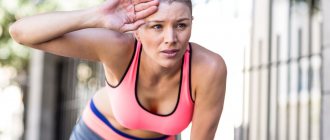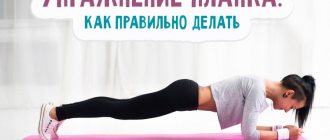Sports life often requires a real masculine performance from beginning athletes, because achieving results in this matter is impossible without constant self-control, training of willpower and spirit. Whatever sport is preferred, it is important to do a proper warm-up before starting training, and here jumping rope will help us, the technique of which often causes some difficulties for both beginners and professionals. Professional sports rarely do without this unique tool, because correctly performed exercises contribute not only to physical strengthening of the body, but also to improved coordination, reaction and even weight loss, but we will talk about this on our blog a little later.

Popular mistakes made by beginners
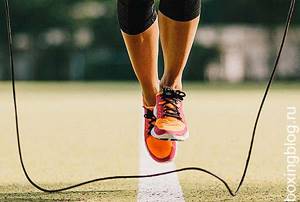
In order to start jumping rope, you don’t need to reinvent the wheel; all the movements here are natural, short and jerky, but at the same time smooth and very accurate. Despite the apparent simplicity of the training, it is first of all important to take the correct starting position so that the exercises bring maximum pleasure and benefit, and not harm. Oddly enough, in order to understand how to do everything correctly and not make mistakes, it is worth familiarizing yourself with the most common mistakes made by beginners when jumping rope, and in real practice there are many of them:
- Let's start with the fact that beginners make their first mistake when choosing the wrong starting position;
- The second popular mistake is not rotating the arms correctly when jumping;
- The third mistake can be called an incorrectly selected surface for jumping rope;
- Often, beginners wear uncomfortable shoes, as a result of which the toes, feet, ankle muscles, knee joints and even back muscles suffer. One mistake can lead to a whole bunch of diseases, causing exercises to turn into sheer torture and not lead to the desired result.
After we have examined the most popular mistakes made by beginners, we will move on to analyzing them in order to understand how to achieve maximum benefits from jumping rope.
Three groups of rules for perfect training with a jump rope
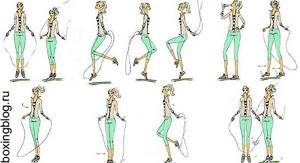
So, in order for the effect of jumping rope to be as beneficial as possible, it is important to choose the right rope, which we will talk about later, and also remember the basic rules, they are the direct antipodes of the mistakes that we discussed above.
First, we take the correct starting position, for this:
- We take a perfectly level position, straighten our back;
- We throw the rope behind our back;
- We bend our arms slightly at the elbows;
- You should move your hands away from your hips by 15-20 centimeters, no more, otherwise you will experience overload;
- You can begin rotating arm movements and jumping.
Secondly, we make the right jumps. To do this, you need to perform a number of preparatory measures, namely:
- Prepare the soil - the ideal option would be a springy surface, such as rubber shock-absorbing mats or gymnastics mats. A great place for jumping rope would be the tennis court;
- Choose the right shoes - they should perfectly absorb shock and relieve stress on the knee and ankle joints. The ideal option is high quality running sneakers;
- We make short jumps so that our feet leave the ground literally a couple of centimeters. It is important to make a perfectly soft landing and not touch the ground with your heel. You should not start making difficult jumps right away, this can lead to undesirable consequences, overloads, sprains, and injuries.
Thirdly, we stick to the training plan:
- We perform a certain number of jumps per day;
- We divide jumps into approaches;
- We give our legs a rest; to do this, just walk at a calm pace for a minute;
- We perform recovery exercises.
Following these simple rules will help create the right atmosphere for exercise, keep your joints in order and significantly improve your physical fitness and health over time. The main thing in this matter is not to overdo it and not to try to prove something to someone.
It is also worth paying attention to the fact that jumping rope is for the most part an activity that complements the main sports activity, and is not considered as a sport, at most - to maintain sports shape in the current state.
Exercises for weight loss
Jumps when using a jump rope are divided into different categories according to the difficulty of execution, taking into account the person’s training, his skills and capabilities. I will introduce you to some of them:
Single jumps on both legs are a classic jumping option. One rotation of the rope and jump on both legs. The jumping speed can be gradually increased. The faster the jumping pace, the faster the calories are burned.
Alternate jumps are very easy to perform. You must jump alternately with your right and then with your left foot; from the outside it looks like running in place, only with a jump rope. This exercise develops movement coordination and burns calories.
Criss-cross jumps are basic and are especially revered among boxers. First, a normal jump is made, and then, the arms are crossed at the level of the elbows, while the rope cord is above the head and another jump is made.
The cross exercise has another modification when arm movements (crossing) are performed behind the back. This is a more difficult exercise.
Jumping with high knees. The exercise itself is simple, similar to classic alternate jumps, only you need to raise your legs high in this exercise, bending them at the knees. Exercise requires a lot of energy.
For other types of exercises, watch the video: 26 exercises on a skipping rope.
What are the contraindications for jumping?
- Jumping, like any physical exercise, has both indications and contraindications.
- It is not recommended to jump for people with sore joints: arthritis and arthrosis.
- Bone and spinal diseases.
- For constant migraines and even rare headaches.
- With increased blood pressure, myocardial infarction, stroke, vascular diseases.
- Overweight, or rather obesity, is also a contraindication. You need to calculate your body mass index to know whether your weight is normal or overweight.
- It is not recommended to exercise on a full stomach. About 2 hours should pass after eating.
Jumping itself puts stress on the blood vessels and even increases blood pressure. Therefore, it is better for people suffering from these diseases to consult a doctor.
Jumping rope is an accessible and enjoyable form of exercise that improves well-being and health. Jumping equipment is not expensive, and you can practice this sport anywhere and at any time.
Read further: Rejuvenation with Tibetan hormonal gymnastics
Be healthy, dear readers!
Blog articles use pictures from open Internet sources. If you suddenly see your author's photo, inform the blog editor about it through the Feedback form. The photo will be deleted or a link to your resource will be provided. Thanks for understanding!
The benefits of jumping rope for children and teenagers
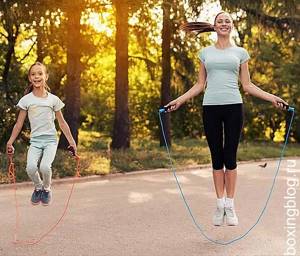
If we talk about jumping rope for preschool children, then there are a number of restrictions and instructions that should be strictly followed so as not to injure the weak child’s body. Let's take a closer look at all the nuances:
- Choosing a jump rope for a child is the most important moment. The thickness of its working part should be strictly in the range from 0.8 to 0.9 cm, so as not to be too light and too heavy. The length should also be optimal; for this, the child must step with his feet in the middle of the rope, grab its ends and stretch his arms in front of him, pulling the rope all the way. The handles should be at armpit level. By the way, the same principle works with selecting the length of a jump rope for adults.
- Next, it is important to explain to your child the correct technique for jumping rope. It is important to hold onto the handles as freely as possible, without straining your hands; the rope itself should hang from the outside of your hands. This is especially important for small children's hands, which are so easily damaged. The elbows are freely lowered, rotation is achieved by light movements of the hands, while the forearms only support the movements of the arms, but do not themselves participate in this movement.
- Jumping must be performed under the supervision of an adult so that the child’s actions are correctly corrected at any time. It is important to monitor posture, correct hand movements and the execution of the jumps themselves. Children should not be allowed to jump too high; on the contrary, a small lift off the ground can also have unpleasant consequences.
For schoolchildren, the rules for performing jumping ropes do not fundamentally change. It is worth noting the importance of this exercise specifically for school-age teenagers. Intensive growth, hormonal imbalances, lack of muscle mass, or, on the contrary, excess weight - a jump rope will help balance a teenager’s physical activity and become an excellent addition to your growing child’s favorite sport. However, special attention should be paid to the technique of performing jumps and the basic universal rules, which we have already discussed above.
How to choose a jump rope and clothes for training?
In order for your jumping rope to be as effective as possible, you need to choose a jump rope that suits you and a comfortable fitness uniform. Please note the following recommendations:
- For high-quality, quick weight loss, you should choose not ordinary jump ropes, but ones with weights that are built into the handles and are available in the jump rope itself. There are jump ropes with a built-in “counter” that counts the number of revolutions made while jumping and the number of calories burned. So, for regular training for the purpose of losing weight, an excellent choice is a jump rope with a weight and an accountant.

- The handles of the jump rope should be as comfortable as possible for the hand - the palm can sweat during training, so the handles should not be slippery, but durable and comfortable for the hand.
- In order to choose the size of the jump rope you need, take the jump rope in front of the mirror and stand in the middle of it with both feet. If its arms reach clearly to the armpit, this is your specimen! If more or less, look at other options.

- Clothes should not be extremely loose, especially if you have problem areas with cellulite and sagging skin. An excellent option is structured leggings and a T-shirt that supports the chest and abs.
Benefits of jumping rope for men
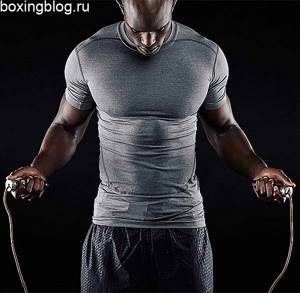
A jump rope can be called indispensable for men who have absolutely no time for training and banal physical exercise. As a rule, these are business and very busy brutal guys of mature age, for whom maintaining ideal physical shape is an extremely important issue. What other benefits can a jump rope bring to men? Let's get a look:
- Everyone knows how cardiovascular diseases are getting younger among males. Properly selected training involving a jump rope will help strengthen the heart and blood vessels, reduce the risk of heart attacks and thrombosis. An important note here is that such activities are contraindicated for men who already have various types of heart disease. In this case, it is better to consult a doctor;
- A pleasant addition to the first point will be a noticeable improvement in a man’s sex life, because strengthening the heart and blood vessels will inevitably lead to an increase in hormones such as endorphin and testosterone;
- An important positive aspect will be increased concentration, which is so important for a modern man. This quality will come in handy at work, at the dacha, in family life, and even while driving. A man should always, at every second of his life, be as coordinated as possible, and a jump rope can help with this best of all.
It’s probably not for nothing that professional boxers practice jumping rope techniques before every training session. Let's look at an effective technique for jumping rope for boxing. Important note: this exercise in no way obliges you to start a professional boxing career; it can be performed by any healthy person, subject to all the rules described above.
Let's look at the boxing technique of jumping rope
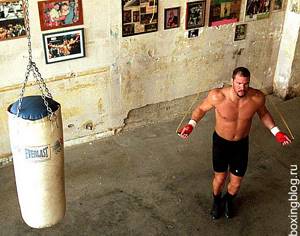
Boxers use a slightly different jumping technique, and the differences here begin with the choice of rope. Let's look at all the nuances of performing this exercise for boxers:
- The rope is chosen to be slightly shorter, at a level below the armpits;
- The jumping surface is harder, but not concrete;
- Minimal movements of the arms, forearms and elbows remain motionless, the hands move almost imperceptibly;
- The distance to the ground from the surface of the feet at the moment of jumping is the smallest - within one centimeter, maximum 2;
- The time for each approach is equal to the time of the round, and the total number of approaches does not exceed 12, which is a high level of skill.
Do you want to feel like a real boxer? Try this jumping technique, but start at the lowest level - 4 rounds.
Types of jumps
Depending on the goal, you can perform different types of jumps: standard, high, single, alternate or double. You just need to remember the correct technique. While jumping, your back should remain straight, your abdominal muscles tense, and your arms at hip level. The ideal jump height is no more than 4 cm, and you need to land softly on the balls of your feet.
- The standard and most popular exercise is single jumps. Even a beginner can do them. The arms should be slightly bent and slightly above hip level, the knees should also bend before the jump and straighten during it. During one swing of the jump rope you need to make 1 jump.
- The high knee raise exercise allows you to quickly remove belly fat and pump up your abdominal muscles. When jumping, you need to raise one knee to hip level, trying to reach higher.
- Single jumps must be taught to do before proceeding to more difficult elements. The ideal performance of this type is characterized by a pace of 100 times without much effort. In addition, it is recommended to learn how to perform high single jumps, using your feet and calves.
- Jumps with alternating legs. To perform this exercise, you need to lift off the floor while jumping, first one leg, and then the other. With the second swing of the cord, the leg is replaced by the opposite one.
- When performing the figure eight element, only the torso and arms work. Starting position – standing, feet shoulder-width apart. You need to take the jump rope in your hands, then make a movement in the air that resembles the number 8, from the right shoulder to the left hip. Repeat for 3-5 minutes, moving in both directions. The legs should not leave the floor or work together with the arms.
- It is impossible to hop on one leg for a long time due to the high load on the ankle. The ideal execution time is no more than 30 seconds on each leg without rest or 20 times of unfunny movements.
- Jumps with alternating changes of legs are performed with a straight back; each jump should be changed to the opposite leg. Perform for at least 3 minutes.
- Jumping with a pelvic rotation is an excellent workout for the abdominal and leg muscles. With each movement, the position of the hips changes: first to the left, then to the right.
- The double jump is the most difficult element of skipping. It is required that during the jump you should make two turns at once with the jump rope. In terms of intensity, such jumps are equivalent to fast running. When performing, you need to jump high enough to make 2 revolutions.
- Doing exercises with straight legs is not recommended. Jumping with your knees straight creates too much pressure on the joint, which often causes injury.
- Side jumping helps develop coordination and speed. They are performed with a slight shift to the side while swinging the rope. Jumping back and forth is performed in a similar manner.
- “High” jumps have a positive effect on the muscles of the buttocks and thighs, for example, the quadriceps. In this case, you need to jump carefully, watching the landing and placing your feet.
Is it possible to lose weight by jumping rope?

But for women, the most attractive aspect of jumping rope will be losing weight, because just for the sake of it, a woman is ready to do almost anything, even daily training.
It is worth noting that to achieve a positive result, months and even years of long-term training must pass, but already in the process of training you will be able to observe how the buttocks are tightened, the stomach and sides gradually disappear.
But don’t hope for a miracle - one day of grueling training will definitely not make those extra pounds go away, but it can easily discourage you from exercising. Therefore, it is important to create a training program with a jump rope, which, by the way, applies to everyone, not just women who want to lose weight.
Since we are talking about losing weight, let’s bring this topic to the end and look at the main types of jumping rope, find out the intensity of burning subcutaneous fat, and try to develop our own set of exercises with a jump rope. Ready? Then let's go!
What muscle groups work when jumping rope?
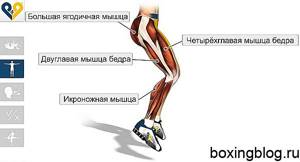
I think that after reading the main part of the article, no one has any questions about how to jump rope at home. We explained how to jump rope correctly - on your toes, but not on your entire foot, and even looked at the technique of jumping on the spot in a boxing style. It's time to analyze in detail other techniques for performing jumping rope, to understand what exercises can be done with a rope other than jumping, but which can also effectively help burn calories. You will learn about all this right now.
First, let's find out which muscles work when jumping rope. This simple-looking exercise uses the following types of muscles:
- Calf;
- Quadriceps;
- Biceps femoris;
- Buttocks;
- Abdominal Press;
- Biceps;
- Muscles of the hands;
- Muscles of the back and neck.
At the same time, to directly perform the jumps themselves, it is enough to use only a couple of muscles, which bear the main load. Other muscle groups maintain balance, stabilize the body when the legs hit the ground, help perform rotational movements, and so on.
As you can see, those parts of the body are mainly involved in which we would like to see positive dynamics in losing weight. That is why jumping rope is one of the most effective ways to reduce overall body weight; moreover, it can tighten the skin, make it even and smooth, as if excess weight had never been there.
After we have figured out which muscles work when jumping rope, let's understand how many calories are burned. With an intense workout for 15 minutes, you can burn no less than 200 kilocalories, which corresponds to 22 grams of fat, respectively. Not bad, right? But in order to lose kilos, you will have to work hard, and a lot.
Training program
Hard training is not suitable for beginner athletes. The load must be increased gradually, moving to more complex elements. After several workouts of 5-7 minutes, you can safely increase the time to 10 minutes a day. The correct program consists of the following exercises:
jumping with alternating legs (reminiscent of a quick step in place);
- walking to the side several steps at a time;
- cross jumps (hands with the rope should be crossed when the rope is above your head);
- jumping on one leg;
- turn while bouncing.
To achieve maximum results, you need to adhere to the training program. If it is difficult to perform the specified amount, you are allowed to reduce their number or change the pace to a slower one.
Week 1-2
For a beginner, the training regime should be 1:2 - jumping lasts 30 seconds and resting for 60. The intensity affects the result, but you should not put too much strain on the body. It is necessary to take short breaks between approaches, and during the working interval perform at least 25 jumps. The number of classes in the first week is 3.
In the second week, the proportion of sports activity and rest is increased, it is 1:1. The number of workouts per week is at least 4. The load time should be up to 3-4 minutes continuously. After the approach, you need to rest for an equal amount of time.
Week 3-4
During this period, there is no need to increase the time of each approach. Attention should be paid to the technique of performing jumps. Unlike previous weeks, jumps need to be done more quickly (about 2 times per second), reaching up to 120 times in 60 seconds. The goal for a month of training is to achieve a 10-minute workout without rest at a fast pace. Regular exercise helps build endurance and tone your figure.
Week 5-6
If it was not possible to achieve the desired result within a month, you can extend the program and improve the technique. For example, the number of workouts should be increased to 6 times a week, and the time should be increased to 30 minutes without rest. In addition to all this, it is recommended to perform other sports elements: side jumps, bending over with a skipping rope, jumping jacks with torso rotation, and stretching with an apparatus.
We perform mandatory warm-up exercises

Let's now look at exercises that will help us, firstly, diversify our activities, and secondly, shift the load from one muscle to another, thereby distributing the load on the entire body as evenly as possible.
Let's start, perhaps, with exercises with a skipping rope without jumping. These exercises are warm-up exercises and mandatory before each workout:
- We spread our arms at shoulder level, take the rope in both hands and begin movements reminiscent of working with oars. In this case, the jump rope should make a movement similar to the infinity sign. This exercise will further relieve stress from your shoulders;
- We lie on our backs, bend our knees to our chests, place a folded rope over the top and pull it down, trying to press our leg as close to our body as possible. The thigh and buttock are actively working here. Next we change the leg;
- We raise our hands, take the rope cord and pull it at shoulder width. By bending left and right, we warm up the oblique muscles, which makes it easier to perform further exercises.
Do not be skeptical about warm-up exercises, because this is the foundation for your future slim body.
Block three - set of general physical fitness exercises No. 1
We will work according to a timer: 20 seconds work, 10 seconds rest. We perform the following set of strength exercises with our own weight:
- Exit by force on the horizontal bar (if that doesn’t work, do pull-ups)
- High jumps from a deep squat
- Elbow plank. Pull the knee to the shoulder
- Scissors. Jumping lunges with alternating legs
- Press. Crossing your legs in front of you while sitting on the floor
- Burpee. Variations of this exercise are possible
After the complex, we restore our breathing and prepare for the next stage. Important: during training, you must drink in small sips every 10-15 minutes to avoid dehydration.
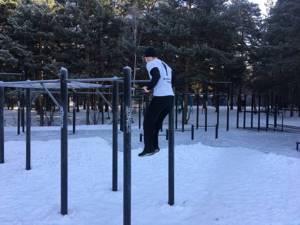
What exercises can complement jumping rope?

Now let's look at three exercises that perfectly complement training using a jump rope:
- Jumping with clap involves performing the exercise from the starting position, which is a regular stance. The jump is performed on the tiptoes, while during the jump the legs are placed to the sides an order of magnitude further than shoulder width. The clap of your hands above your head should occur at the moment your feet touch the floor. You should maintain a curved back and a level head to avoid injury to the muscles of the neck or lower back;
- Star jumps are not much different from the first exercise. The main difference is the absence of cotton. On the one hand, this relieves tension from one muscle group, but makes another work. This exercise actively involves the triceps, ankle muscles, back and neck muscles;
- Jumping Jack, or, in simple translation into Russian, Jumping Jack can easily be confused with an asterisk or jumping with clap, because often when performing this exercise they clap their hands. However, this exercise still has a few differences. Firstly, it is rhythmic. The exercise is performed at an accelerated pace, while performing Jack jumps requires more approaches to obtain maximum results.
An important point when performing the last exercise is breathing. When performing the first movement, a sharp and deep exit is made. Taking the starting position is accompanied by an equally sharp breath. The exercise is characterized by an increased cardio load, so it should be performed by people without the slightest hint of cardiovascular disease.
TOP 6 exercises with a skipping rope
The most popular use of the exercise is as a warm-up. However, adding small changes to the classic jumping technique can provide much more benefits, becoming one of the main exercises.
Warm-up
Warm-up is a classic exercise that is used most often. They begin to learn jumping from him. Only after complete mastery and 100 jumps without a break during one set, should you proceed to more complicated options. The basic version consists of low, frequent jumping while skipping the rope under your feet. The lower and more often the jumps, the more effectively the exercise works the calf muscles, ankles and hips. When performing, the elbows are moved a few centimeters away from the body, the shoulders move freely, and the body is tense.
Low, frequent jumps provide a very good load on the calf muscles and upper thighs. The pulse is activated, the abdominal and arm muscles work.




